不同喷油定时乙醇/柴油RCCI低负荷燃烧与排放特性
2018-10-19韩伟强李博仑潘锁柱
韩伟强,李博仑,董 超,潘锁柱,李 鑫
不同喷油定时乙醇/柴油RCCI低负荷燃烧与排放特性
韩伟强1,2,李博仑1,2,董 超3,潘锁柱1,2※,李 鑫1,2
(1. 流体及动力机械教育部重点实验室(西华大学),成都 610039; 2.汽车测控与安全四川省重点实验室(西华大学),成都 610039; 3. 国家汽车质量监督检验中心,襄阳 441004)
在总循环能量与乙醇能量替代比不变的条件下,研究了不同柴油喷油定时(start of injection, SOI)下乙醇/柴油活性控制压燃(reactivity controlled compression ignition, RCCI)六缸增压柴油机低负荷的燃烧与排放特性。结果表明,随着SOI的提前,RCCI冷焰反应相位提前,高温放热的瞬时放热率峰值先增大后减小,滞燃期逐渐增大,缸内燃烧温度逐渐增加,燃烧重心先提前后推迟。传统燃烧模式(conventional combustion mode, CCM)与RCCI的燃烧特性差异随着SOI的提前而增大。与CCM相比,RCCI的NOx排放的减少量随着SOI的提前而增加,HC与CO排放的增加量随着SOI的提前而减少。随着SOI的提前,粗态(>273.8~1 000 nm)颗粒物质量分数从84.09%减小到32.87%。聚集态(>13.3~273.8 nm)颗粒物质量分数从15.88%增加到66.36%。与CCM相比,RCCI的颗粒物排放的数量浓度较少,尤其是核态颗粒物;但RCCI颗粒物排放质量浓度较高。
柴油机;燃烧;排放控制;喷油定时;活性控制压燃;乙醇;颗粒物
0 引 言
均质压燃(homogeneous charge compression ignition,HCCI)发动机在低负荷时(如平均有效压力(brake mean effective pressure,BMEP)<0.2 MPa),适宜采用活性较高的燃料(十六烷值≈45)来改善燃烧。而负荷增加时,为了减缓化学反应速度并推迟着火,需要降低燃料活性,从而拓展HCCI发动机负荷(可达1.6 MPa)[1-2]。基于此,学者们提出了活性控制压燃(reactivity controlled compression ignition, RCCI)的燃烧模式。RCCI能够在燃烧前使缸内混合气形成活性分层[3]。通过控制缸内混合气的活性分层来达到缸内燃烧过程的可控。从而达到当量比分层梯度,燃烧相位,燃烧温度和压力升高率的可控[4]。与传统柴油燃烧相比,RCCI燃烧温度较低,从而使NOx排放量降低[5-6];并且,RCCI燃烧的滞燃期较长,柴油混合时间增加以及低活性燃料的预混使缸内局部浓区较少,从而减少了碳烟的排放[5]。
尽管RCCI在控制燃烧相位与降低压力升高率等方面具有明显优势,但RCCI燃烧在低负荷时HC和CO排放较高[7-10]。这主要是因为大量低活性燃料扩散到了狭缝等低温区域,并且低负荷下RCCI燃烧温度较低[11]。低负荷时,RCCI燃烧还具有滞燃期较长,柴油喷射初始温度较低等特点。滞燃期与柴油喷射初始温度都对缸内活性分层有很大影响。
生物乙醇是一种前景广阔的可再生能源[12],其含氧量高达34.8%[13-14],有利于燃烧的改善。生物乙醇是一种碳中性燃料。乙醇汽化潜热较高,有利于降低新鲜充量的温度。因此,目前乙醇广泛应用于RCCI发动机上[15]。Işik等[16]以乙醇作为低活性燃料进行了RCCI燃烧试验研究,研究得出随着乙醇预混比的增加,燃烧速度加快,散热量减少,累计放热量增加;随着乙醇预混比例的增加,柴油喷射量减少,滞燃期增加,碳烟排放减少。另外由于乙醇汽化潜热较大,随着乙醇预混比例的增加,缸内燃烧温度降低,NOx排放降低。乙醇/柴油的RCCI燃烧在实现NOx排放大幅降低的同时,实现了高热效率[17]。由此看出,乙醇在RCCI燃烧低负荷拓展方面展现出很大潜力。但乙醇汽化潜热较大,在低负荷会大幅降低新鲜充量的温度,引起燃烧效率降低,使HC和CO排放增加。
高活性燃料的柴油喷油定时(start of injection, SOI)对RCCI燃烧的活性分层有很大影响,从而很大程度地影响到整个燃烧过程。很多学者研究了SOI对RCCI燃烧和排放特性的影响。Zheng等[18]以乙醇为低活性燃料进行了研究了SOI对RCCI排放的影响。SOI为−4~−14 °CA ATDC。研究得出,随着SOI的提前,NOx排放逐渐增大,THC和CO排放逐渐增加,soot排放逐渐减小。Wang等[19]在SOI为−15~−75 °CA ATDC的条件下,研究了不同高活性燃料的十六烷值对RCCI排放的影响。
综上所述,乙醇在RCCI燃烧上的应用以及SOI对RCCI燃烧排放的影响得到了广泛研究,但是未能得出SOI对以乙醇为低活性燃料的RCCI燃烧和排放的完整影响规律。SOI对RCCI燃烧的颗粒物排放特性的研究较少,并且在超低负荷(BMEP≈0.1 MPa)工况下的对RCCI燃烧的研究较少。本文基于一台六缸重型柴油机,在BMEP≈0.1 MPa的超低负荷下探讨了不同SOI(−6~−40 °CA ATDC)下乙醇/柴油RCCI低负荷的燃烧与排放特性,详细分析了喷油定时对乙醇/柴油RCCI燃烧的瞬时放热率、燃烧相位和燃烧温度等燃烧状态参数,以及NOx、HC、CO和颗粒物的较完整的影响规律,并对比了RCCI燃烧以及CCM燃烧的燃烧状态以及排放水平。
1 设备与方案
1.1 发动机参数
文章基于一台六缸四冲程涡轮增压柴油发动机进行研究。该发动机的具体参数见表1。

表1 柴油机技术参数
1.2 燃料与供油系统
为了分析不同SOI对双燃料燃烧排放的影响。采用进气歧管喷射低活性燃料乙醇,缸内直喷高活性燃料柴油。保持每缸每循环总输入能量为1 281 J。乙醇能量替代比为40%。燃料物理化学性质如表2所示。

表2 燃料性质
1.3 数据测量与采集系统
图1为六缸重型柴油机试验测试平台示意图,由图1可知,该平台主要包括试验发动机、试验测试设备、数据采集系统及燃烧分析系统。
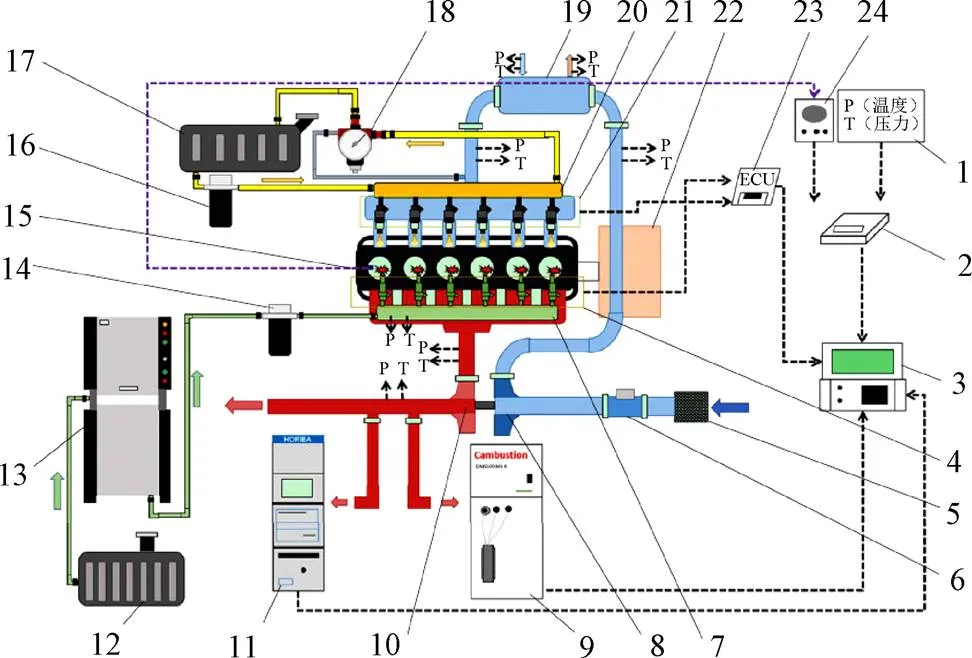
1.温度压力信号 2.采集卡 3.电脑 4.柴油喷油器 5.空气滤清器 6.空气流量计 7.高压共轨 8.增压器 9.颗粒物分析仪 10.涡轮机 11. 气体分析仪 12.柴油油箱 13.油耗仪 14.柴油滤清器 15.缸压传感器 16.低活性燃料滤清器 17.低活性燃料油箱 18.背压控制阀 19.空气中冷器 20.低活性燃料油轨 21. 进气口喷油器 22.测功机 23.电子控制单元 24.电荷放大器
如图1所示,在离排气口2 m处的位置安装了尾气取样口,利用Horiba-MEXA7100DEGR排放仪测量常规排放,利用DMS 500 Mk II测量颗粒物的粒径分布。分别采用CMFD015油耗仪和Toceil20N80热膜式流量计测量油耗和空气流量。各个测量设备与采集设备精度如表3所示。
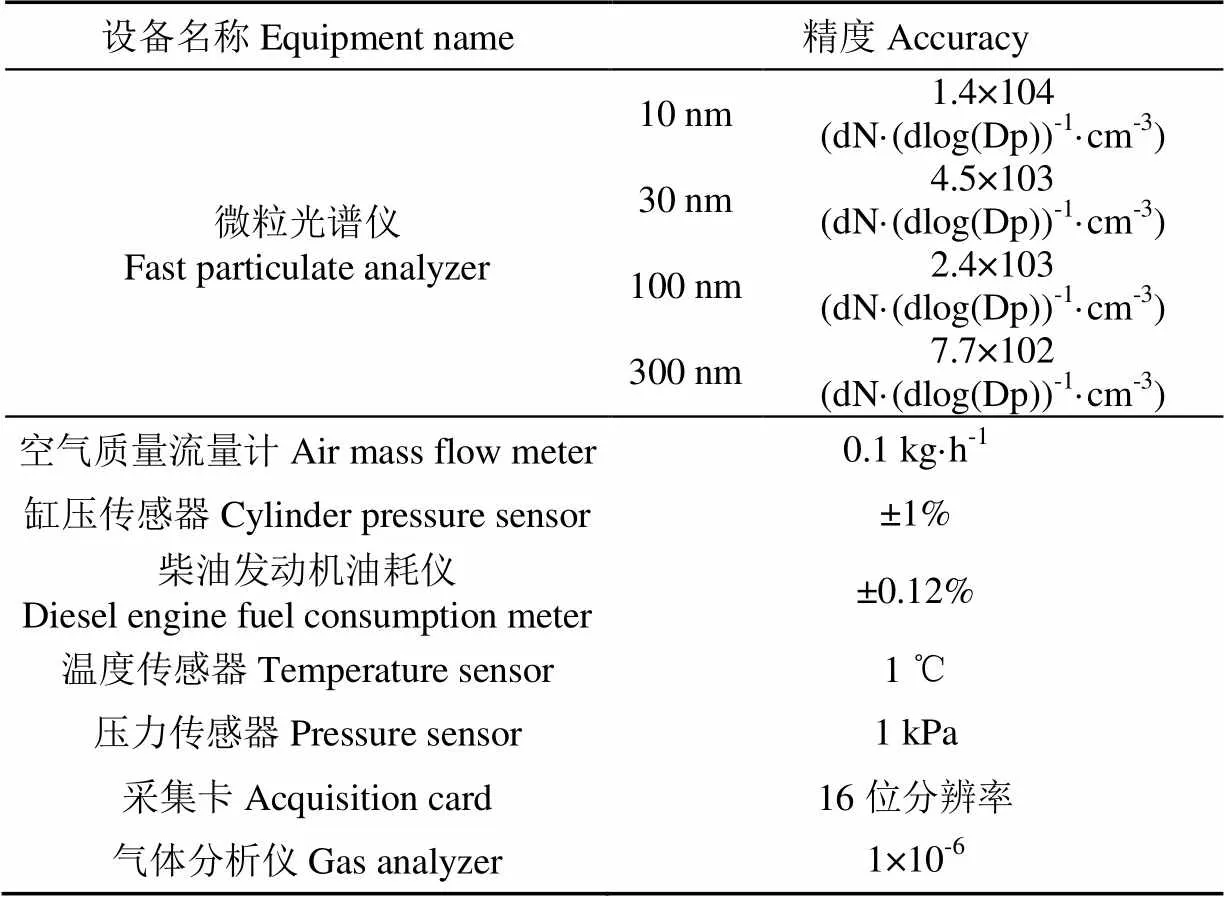
表3 测量设备规格及精度
试验中燃烧分析所用的缸压是由Kistler 6125C缸压传感器和Kistler 5011B电荷放大器进行测量并由NI-USB6353采集卡进行采集的。每个工况采集50个循环的缸压曲线。采集到的缸压数据经由LabVIEW编写的离线燃烧分析系统来求平均并计算瞬时放热率和缸内平均温度。瞬时放热率是根据热力学第一定律计算出来的,气缸内能量守恒由式(1)表示[21-22]。
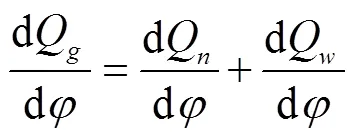

式中为热容比,由式(3)表示[23];为缸压,MPa;为气缸容积,m3。
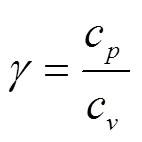
式中c为定压比热容,J/(kg·K);c为定容比热容,J/(kg·K)。

式中A为燃烧室表面积,m2;h由Woschni模型估算得出;为缸内平均温度,K;T为燃烧室温度,K;为发动机转速,r/min。
缸内平均温度由式(5)表示[21]

式中为气缸内气体质量,kg;为理想气体常数。
气体排放物由MEXA-7100D分析仪进行分析。检测结果为气体质量浓度,通过式(6)计算出CO、THC和NOx的质量排放量(g/kW·h)[25]

式中表示被测排放物,分别为CO,THC,NOx。g/kW·h表示单位为g/kW·h的排放物的量;C表示被测排放物对应的常数,其中CO=0.000 966,THC=0.000 479,NOx=0.001 587。wet表示单位为1×10-6的排放物的量;EXHW表示发动机排出的废气的平均分子质量流量,g/h;表示发动机功率,kW。
考虑到气体湿度对NOx生成的影响,需要对MEXA-7100D测量出的NOx值进行修正,修正后[NOx]wet为

式中[NO]为测量出的数值;k,D为无量纲修正系数,如式(8)所示[25]。

式中为发动机进气湿度;为发动机进气温度,K。
1.4 发动机运行工况与控制条件
试验过程中,保持发动机转速为1 500 r/min。SOI范围为−6~−40 °CA ATDC。发动机控制参数见表4。
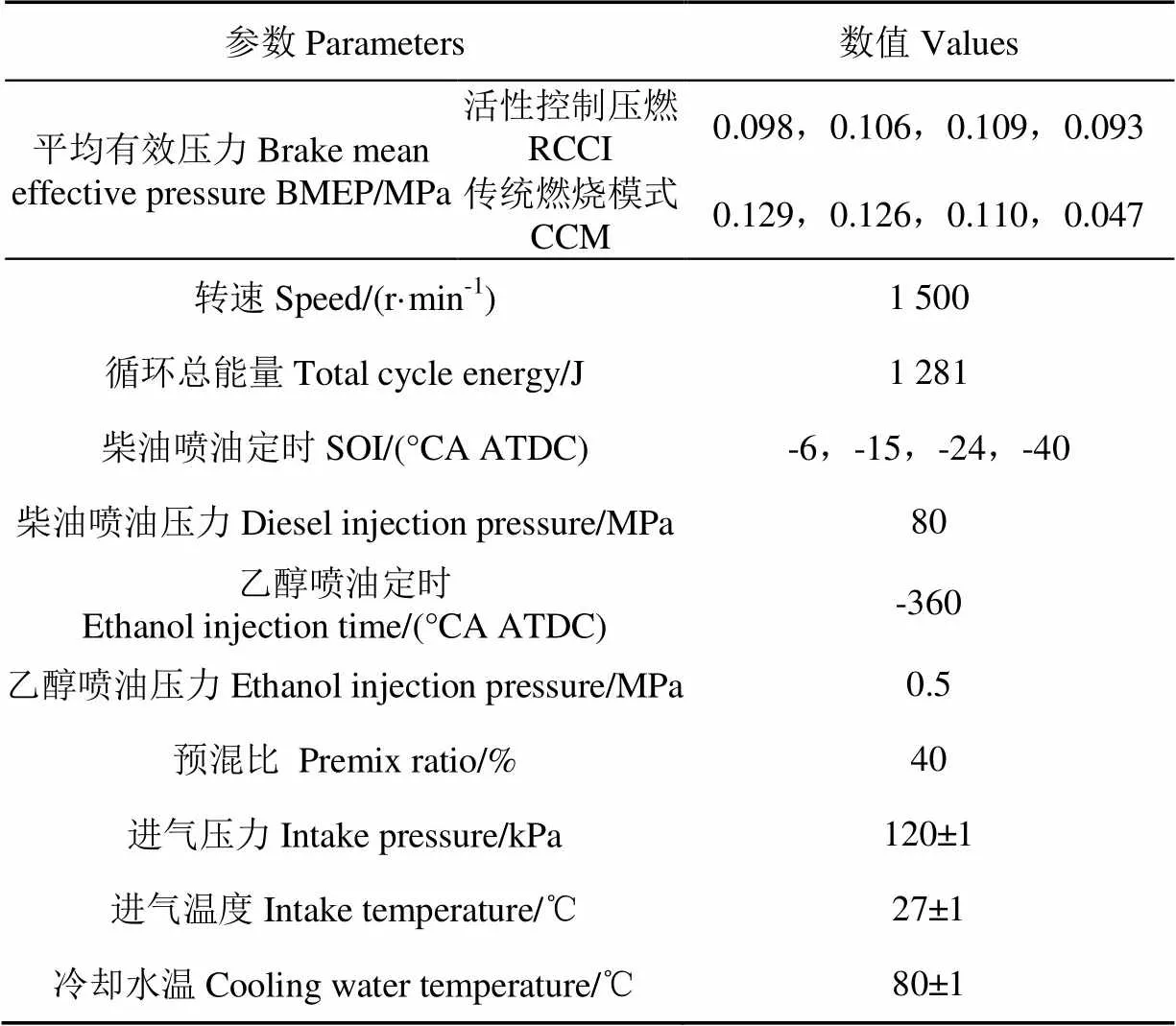
表4 发动机运行条件
注:循环总能量为发动机每循环每缸输入燃料所含的总能量;预混比为发动机输入乙醇所含能量占总能量的比例。
Note: Cycle total energy is the total energy contained in the fuel injected per cylinder per cycle of the engine. Premixed ratio is the ratio of the energy contained in the ethanol to total energy input into the engine.
2 结果与分析
2.1 SOI对燃烧的影响
SOI时刻的改变会影响柴油喷入的环境温度和压力,从而影响柴油的混合时间,进而影响缸内的当量比分层和活性分层,最终影响燃烧过程。
图2描述了SOI对RCCI燃烧和CCM燃烧的瞬时放热率和缸压。由图可知,RCCI燃烧分为高活性燃烧阶段和低活性燃烧阶段。喷油定时较提前时还出现了明显的独立的冷焰反应阶段。

注:图例中数字的单位为°CA ATDC,下同。
通过分析SOI对RCCI燃烧的冷焰反应的影响可知,随着SOI的提前,冷焰反应相位前,冷焰反应持续期增加且放热率幅值增大。冷焰反应是指在温度高于800 K,低于850 K的环境内[26-27],大分子的过氧化物离解为几个自由基,大量自由基引发链分支反应迅速进行的放热反应。由此可知,能够产生独立明显的冷焰反应放热的条件是具有足够多的大分子过氧化物和适当的温度。在SOI接近上止点时没有明显独立的冷焰反应的原因是:从开始喷油到缸内温度符合冷焰反应条件而不符合高温反应条件的时间很短,柴油预混比例极小,能够进行冷焰反应的过氧化大分子很少。SOI提前到一定程度时,出现明显的独立的冷焰反应放热。并随着SOI的提前,冷焰反应阶段相位提前,持续期增长。其主要原因是:随着SOI的提前,柴油预混的时间提前,产生过氧化大分子的时刻提前;从开始喷油到缸内温度符合冷焰反应条件而不符合高温反应条件的时间增加,预混比例较大,能够达到冷焰反应的当量比条件的柴油量较多,在发生冷焰反应之前产生的过氧化大分子的量增加。
通过分析SOI对RCCI高活性燃烧阶段的影响可知,随着SOI的提前,高活性燃烧阶段放热率峰值先增大后减小。从SOI=−6 °CA ATDC到SOI=−15 °CA ATDC,随着SOI的提前,高活性燃烧阶段的放热率峰值增加的原因是:随着SOI的提前,滞燃期增加,如图3所示,柴油混合时间更长,柴油预混比例增加,在达到高温反应温度时缸内同时符合着火条件的区域更多,燃烧更加剧烈。与SOI=−15 °CA ATDC相比,SOI=−24 °CA ATDC的高活性燃烧阶段峰值略微降低。主要原因是:SOI提前,滞燃期进一步增加,如图3中SOI对滞燃期的影响规律所示,柴油混合时间较长,柴油预混比例较大,缸内活性梯度较低,达到高温反应温度时,高活性区域减少。从SOI=−24 °CA ATDC到SOI=−40 °CA ATDC,高活性燃烧阶段放热率峰值大幅减小,主要原因是:SOI提前,滞燃期大幅度增加,柴油混合时间大幅度增加,达到高温反应温度时的缸内活性梯度和当量比梯度大幅度降低,高活性区域大幅减少。

图3 SOI对滞燃期的影响
通过分析SOI对RCCI低活性燃烧阶段的影响可知,随着SOI的提前,低活性燃烧阶段的放热率幅值逐渐增加。这主要是因为随着SOI的提前,滞燃期增加,如图3所示,柴油混合时间增加,活性和当量比梯度减小,低当量比区域的柴油增加,活性增加,燃烧速度增大。
通过对比RCCI和CCM的燃烧过程可知,RCCI燃烧放热率峰值较低。这主要是因为,RCCI燃烧缸内总活性较低,燃烧速度较慢。随着SOI的提前,2种燃烧模式的放热率峰值差异逐渐增大。这主要是因为,随着SOI的提前,与CCM相比,RCCI的滞燃期增加幅度较大,柴油量较低,缸内高活性区域大幅减少,燃烧速度大幅降低。与CCM燃烧相比,RCCI燃烧缸压较低。这主要是因为,与CCM燃烧相比,RCCI燃烧放热率峰值较低,燃烧相位较接近上止点。
由图3中SOI对RCCI和CCM滞燃期的影响规律可知,与CCM燃烧相比,RCCI燃烧滞燃期较长,且随着SOI的提前,CCM和RCCI燃烧滞燃期差异逐渐增加。这主要是因为RCCI燃烧的柴油喷油量较少,燃烧初期符合燃烧的混合状态的柴油较少,RCCI燃烧初始燃烧的柴油量较少。随着SOI的提前,RCCI燃烧的柴油混合程度增大,与CCM燃烧相比,RCCI燃烧初期局部高活性区域较少,初始燃烧所需的温度较大。
图4描述了SOI对RCCI和CCM的燃烧相位和燃烧持续期的影响规律。一般以CA10作为燃烧开始时刻,以CA50作为燃烧重心,以CA90作为燃烧结束时刻。CA10和CA90之间的时间间隔作为燃烧持续期。
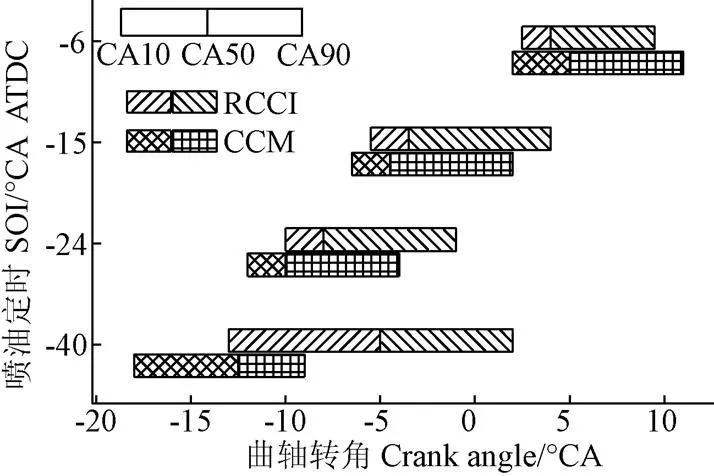
注:CA10、CA50和CA90分别表示燃烧累积放热量为总放热量的10%、50%和90%时对应的曲轴转角。
通过对燃烧相位和燃烧持续期的分析可知,随着SOI的提前,RCCI燃烧缸内着火时刻逐渐提前,燃烧重心先提前后推迟,燃烧持续期逐渐增大;与CCM燃烧相比,RCCI燃烧相位较迟,且随着SOI的提前,2种燃烧模式的燃烧相位差异逐渐增大。
图5描述了SOI对缸内平均温度和累积放热量的影响。由图5a中SOI对缸内平均温度的影响可知,随着SOI的提前,缸内平均温度峰值逐渐增大,而缸内平均温度快速增加部分的温度先增大后减小。通过将图5a中缸内平均温度曲线与图5b中累积放热量曲线进行对比可知,缸内平均温度增大部分的曲线以及SOI=−24 °CA ATDC与SOI=−40 °CA ATDC的缸内平均温度相等的时刻都与累积放热量基本一致。由此可知,RCCI燃烧的缸内累积放热量的变化过程对缸内平均温度起决定性作用。
通过对比RCCI和CCM的缸内平均温度曲线可知,RCCI燃烧温度较低,且高温持续期较短。这主要是因为与CCM燃烧相比,RCCI燃烧累计放热量较小。

图5 SOI对缸内平均温度和累计放热量的影响
2.2 SOI对排放的影响
SOI对RCCI燃烧过程有较大影响,因此SOI会对燃烧产物产生较大影响。图6描述了SOI对RCCI和CCM的主要气体排放物的影响规律。
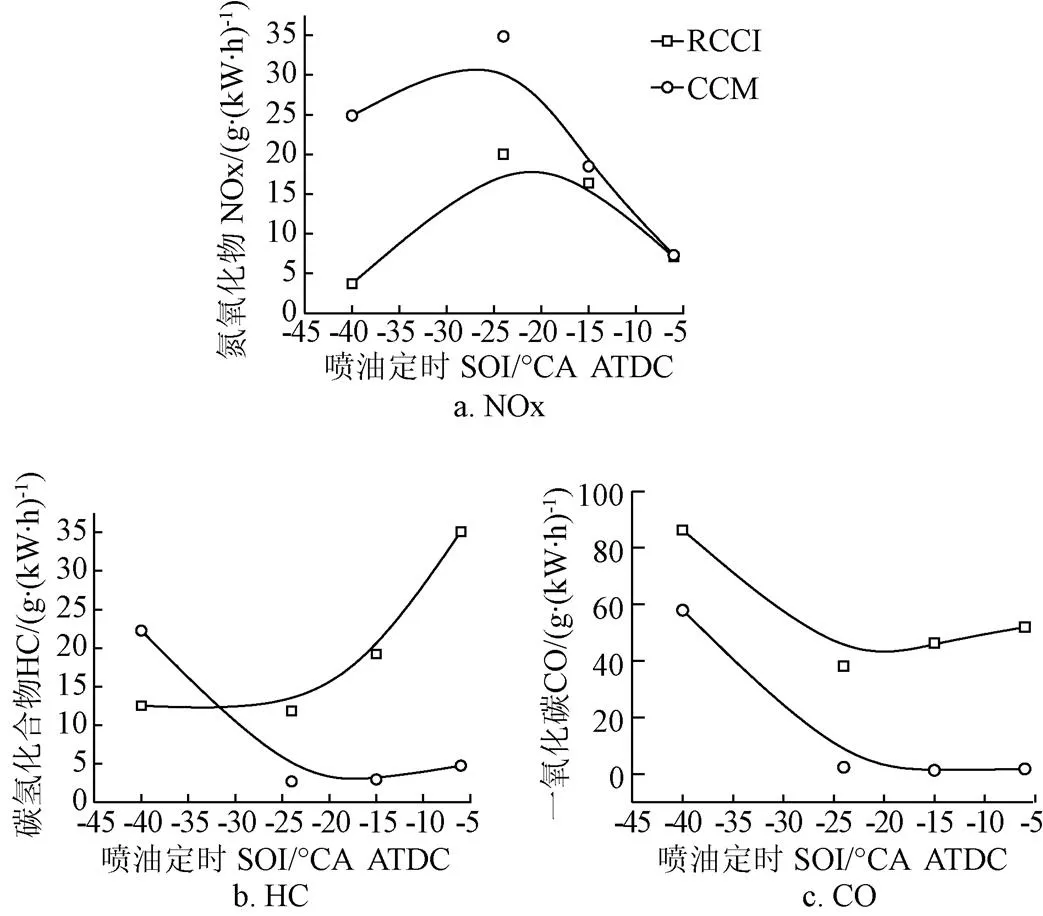
图6 SOI对主要气体排放物的影响
由图6a中SOI对NOx的影响可知,随着SOI的提前,NOx排放量先增大后减小。SOI=−6~−24°CA ATDC时,随着SOI提前,NOx逐渐增大。这主要是因为,SOI=−6~−24 °CA ATDC的前期燃烧的速度整体上随着SOI的提前而增大,前期的高活性燃烧阶段结束时缸内高温区域随着SOI的提前而增多[28-30];并且燃烧结束时,缸内的整体温度随着SOI的提前而增大,如图5所示。与SOI=−24 °CA ATDC相比,SOI=−40 °CA ATDC的NOx排放量急剧下降。这主要是因为:虽然SOI=−40 °CA ATDC的缸内平均温度峰值略大于SOI=−24°CA ATDC,但是SOI=−40 °CA ATDC的活性分层梯度很小,局部高活性区域很少[29-32],整体燃烧非常缓慢,局部高温区域少,且高温区域的温度较低。
与CCM燃烧相比,RCCI燃烧的NOx排放较低。这主要是因为,与CCM燃烧相比,RCCI燃烧温度较低,高温持续期较短,如图5所示。随着SOI的提前,CCM和RCCI燃烧的NOx排放差异逐渐增大。这主要是因为,随着SOI的提前,CCM和RCCI的燃烧温度差异逐渐增大。
由图6b中SOI对HC的影响可知,随着喷油定时SOI的提前,HC排放量减少。这主要是因为随着喷油定时的提前,滞燃期增加,柴油混合时间增长,柴油分布区域增加,初始着火区域增大[30],并且低活性区域减少,火焰传播阻力减小;缸内燃烧温度增加,促进HC的氧化。与SOI=−24 °CA ATDC相比,SOI=−40 °CA ATDC的HC排放量只是略微增加。这主要是由于虽然SOI=−40 °CA ATDC时的滞燃期很长,导致柴油大量扩散到火力岸等狭缝中。由于燃烧持续期很长,缸内火焰传播范围广,局部温度高,且高温区域多[28],致使HC能够较充分燃烧。在SOI=−6~−33 °CA ATDC时,与CCM燃烧相比,RCCI燃烧的HC排放较高;在SOI=−33~−40 °CA ATDC时,与CCM燃烧相比,RCCI燃烧的HC排放较低。这主要是因为在SOI=−6~−33 °CA ATDC时,与CCM相比,RCCI燃烧温度较低,高温持续期较短。在SOI=−33~−40 °CA ATDC时,与CCM相比,RCCI的燃烧持续期较长。并且由图3可知,RCCI燃烧滞燃期较长,RCCI燃烧的柴油蒸发时间较长,燃烧较良好。
由图6c中SOI对CO的影响可知,随着SOI的提前,RCCI燃烧的CO排放量先小幅度减小后大幅度增加。从SOI=−6 °CA ATDC到SOI=−24 °CA ATDC,CO排放量减小的原因是缸内燃烧温度增加。并且,滞燃期增加,缸内混合时间增加,局部贫氧区域减少。与SOI=−24 °CA ATDC相比,SOI=−40 °CA ATDC的CO排放量大幅增加的主要原因是:SOI=−40 °CA ATDC的燃烧持续期较长,且前期燃烧缓慢,燃烧温度较低,由图5可知,导致大量HC在后期燃烧;而后期燃烧温度较高,由图5可知,HC氧化速度较快,导致局部处于缺氧状态,致使CO生成量较大而氧化量较小。与CCM相比,RCCI燃烧CO排放较高。这主要是因为RCCI燃烧温度较低,如图5所示。随着SOI的提前,CCM燃烧和RCCI燃烧的CO排放差异逐渐减小。这主要是由于随着SOI的提前,与RCCI燃烧相比,CCM燃烧恶化程度较大。因此随着SOI的提前,与RCCI燃烧相比,CCM燃烧CO增加幅度较大。
图7描述了SOI对RCCI和CCM固体排放物粒径分布的影响。对于RCCI燃烧,粒径范围为4.87~13.3 nm的核态颗粒物数量浓度较大。粒径范围为13.3~273.8 nm的聚集态颗粒物和粒径范围为273.8~1 000 nm的粗态颗粒物数量浓度较小。SOI=−6~−24 °CA ATDC时,随着SOI的提前,核态和聚集态颗粒物排放量都逐渐减小。其主要原因是随着SOI的提前,滞燃期逐渐增大,由图3所示,柴油的混合时间更长,当量比梯度减小,局部浓区减少[33],核态颗粒物的生成量减少,从而导致核态颗粒物之间的碰撞概率减小,导致聚集态颗粒物数量也减小[34]。并且,随着SOI的提前,缸内燃烧温度和燃烧持续期增加,更有利于碳烟的氧化。与SOI=−6~−24 °CA ATDC相比,SOI=−40 °CA ATDC的粒径分布规律有很大差别。虽然SOI=−40°CA ATDC的滞燃期比其他SOI大很多,但是其颗粒物的总排放量却最大。由此得出SOI=−40 °CA ATDC的颗粒物产生途径和颗粒物结构与其他SOI不同。其主要原因是,柴油喷油时,缸内的温度和压力都很低,柴油喷雾贯穿距离很大,很大一部分燃油喷出后都发生了撞壁,较低的壁面温度造成柴油附着在壁面上,从而造成大量碳烟颗粒生成[35],缓慢的燃烧导致缸内空气流动剧烈程度不够,所以没有造成聚集态颗粒物集中形成。

图7 SOI对RCCI燃烧和CCM燃烧排放的颗粒物数量浓度粒径分布的影响
与CCM燃烧相比,RCCI燃烧的核态颗粒物数量和粒径范围为>13.3~273.8 nm的聚集态颗粒物数量浓度大幅减小,尤其是核态颗粒物,这与其他专家研究结果一致[8,17,36]。而RCCI燃烧的粒径范围为>273.8~1 000 nm的粗态颗粒物数量浓度较大,尤其是SOI=−6 °CA ATDC时。RCCI核态颗粒物数量较少的原因之一可能是其大量聚集成了聚集态的颗粒物。
图8描述了SOI对固体排放物表面积浓度与质量浓度的影响规律,图8a中描述的颗粒物表面积浓度是指单位体积废气中固体排放物的表面积。随着SOI的提前,CCM和RCCI燃烧的颗粒物总表面积浓度先减小后增大。与CCM相比,在SOI=−6~−24 °CA ATDC时,RCCI燃烧颗粒物总表面积浓度较大,且随着SOI的提前,差值逐渐减小。在SOI=−24~−40 °CA ATDC时,RCCI燃烧颗粒物排放表面积浓度较小,且随着SOI的提前,差值逐渐增大。
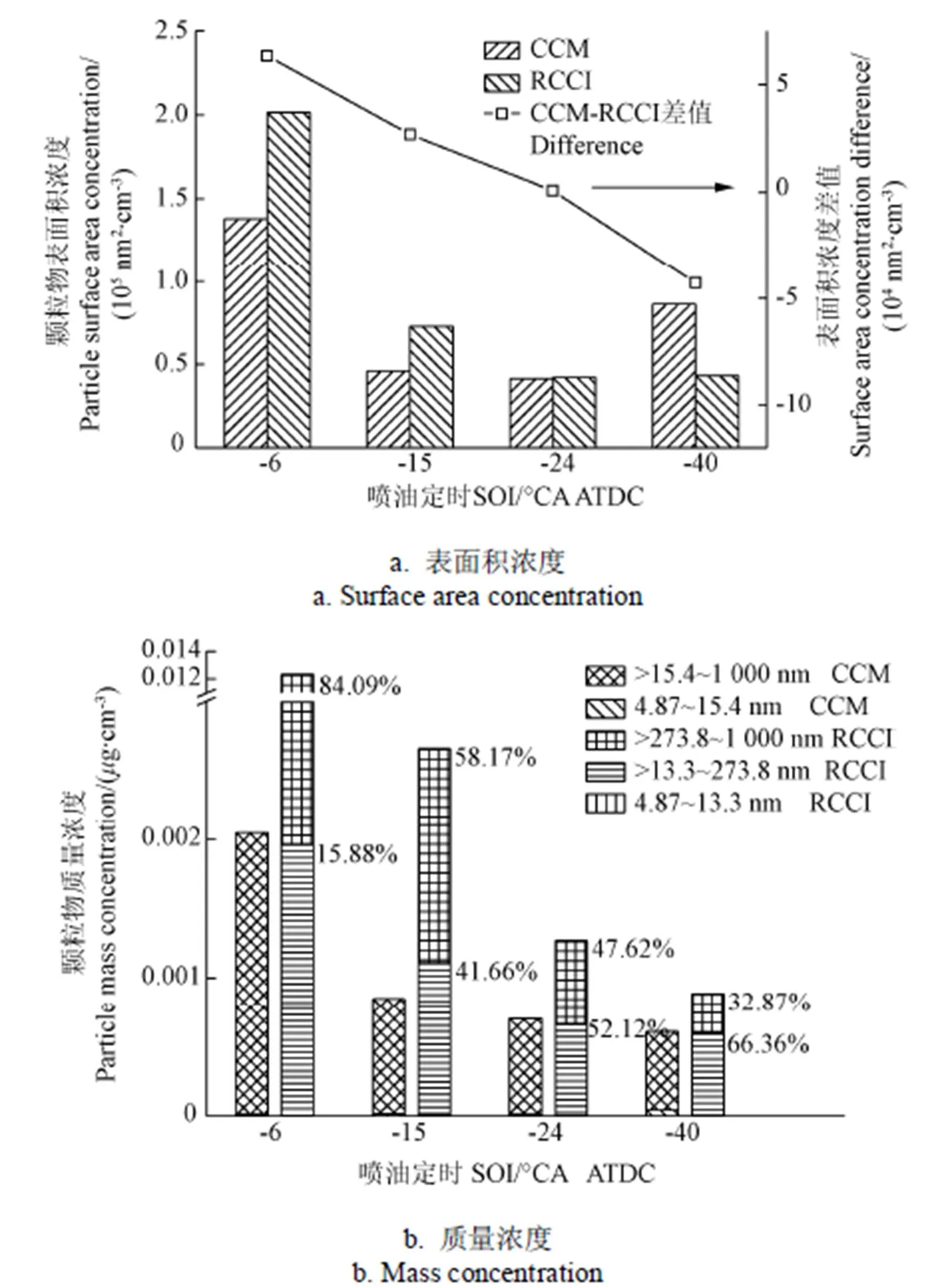
注:图中的百分数代表RCCI的粒径为>273.8~1 000 nm和>13.3~273.8 nm的颗粒物排放质量占RCCI的总颗粒物排放质量的比例。
图8b描述了SOI对单位体积废气中固体排放物的质量的影响,并描述出了SOI对RCCI的不同粒径范围的固体排放物质量浓度占总浓度的比例。随着SOI的提前,颗粒物排放质量大幅度减小。核态颗粒物质量所占比例极小,颗粒物排放质量由聚集态和粗态颗粒物质量决定。对于RCCI燃烧,随着SOI的提前,粗态(>273.8~1 000 nm)颗粒物质量所占的比例从84.09%减小到32.87%,聚集态(>13.3~273.8 nm)颗粒物质量所占比例逐渐从15.88%增加到66.36%。与CCM燃烧相比,RCCI燃烧排放的颗粒物质量较大,这与其他专家研究结果相矛盾[8, 17]。RCCI燃烧排放的颗粒物质量大于CCM燃烧的部分主要在于粗态颗粒物。RCCI燃烧排放的颗粒物质量较大的主要原因在于:颗粒物的主要组成部分是碳烟,而RCCI燃烧的温度较低,由图5可知,致使碳烟氧化困难。
3 结 论
1)随着SOI的提前,RCCI燃烧冷焰反应放热率逐渐增大,高温放热放热率峰值先增大后减小,滞燃期逐渐增大,燃烧持续期逐渐增大,燃烧重心先提前后推迟,缸内最大爆发压力先增大后减小,缸内平均温度峰值逐渐增大。缸内平均温度主要取决于累积放热量。随着SOI的提前,CCM与RCCI的燃烧特性差异逐渐增大。
2)随着SOI的提前,RCCI燃烧的NOx排放先增大后减小,HC排放逐渐减小,CO排放先小幅度减小后大幅度增大。与CCM燃烧相比,RCCI燃烧的NOx排放的减少量随着SOI的提前而增加,HC排放的增加量随着SOI的提前而减小,CO排放的增加量随着SOI的提前而减小。在SOI足够提前时,低负荷时RCCI燃烧的HC排放能够低于CCM燃烧。
3)随着SOI的提前,RCCI燃烧颗粒物数量先减小后增加,颗粒物表面积先减小后小幅增大,颗粒物排放质量浓度逐渐减小。与CCM燃烧相比,RCCI燃烧颗粒物排放数量较少。随着SOI的提前,RCCI燃烧颗粒物排放的表面积浓度逐渐减小。与CCM相比,在SOI=−6~−24 °CA ATDC时,RCCI燃烧颗粒物排放表面较大,在SOI=−6~−24 °CA ATDC时,RCCI燃烧颗粒物排放表面较小。随着SOI的提前,RCCI燃烧的颗粒物排放的质量浓度逐渐减小,粒径范围为>13.3~273.8 nm的颗粒物质量浓度在总颗粒物排放的质量浓度中所占的比例逐渐增大,粒径范围为>273.8~1 000 nm的颗粒物质量浓度在总颗粒物排放的质量浓度中所占的比例逐渐减小。与CCM相比,RCCI燃烧颗粒物排放质量增加量随着SOI的提前而减小。
[1] Bessonette P W, Schleyer C H, Duffy K P, et al. Effects of fuel property changes on heavy-duty HCCI combustion[J]. SAE Technical Paper, 2007-01-0191.
[2] Hildingsson L, Johansson B, Kalghatgi G T, et al. Some effects of fuel autoignition quality and volatility in premixed compression ignition engines[J]. SAE Int J Engines, 2010, 3(1): 440-460.
[3] Zhou D, Yang W, Zhao F, et al. Dual-fuel RCCI engine combustion modeling with detailed chemistry considering flame propagation in partially premixed combustion [J]. Applied Energy, 2017, 203: 164-176.
[4] Li J, Yang W, Zhou D. Review on the management of RCCI engines [J]. Renewable and Sustainable Energy Reviews, 2017, 69: 65-79.
[5] Pan S, Li X, Han W, et al. An experimental investigation on multi-cylinder RCCI engine fueled with 2-butanol/diesel[J]. Energy Conversion and Management, 2017, 154: 92-101.
[6] Benajes J, Molina S, García A, et al. Effects of direct injection timing and blending ratio on RCCI combustion with different low reactivity fuels[J]. Energy Conversion and Management, 2015, 99: 193-209.
[7] Qian Y, Ouyang L, Wang X, et al. Experimental studies on combustion and emissions of RCCI fueled with n-heptane/alcohols fuels[J]. Fuel, 2015, 162: 239-250.
[8] Wang Y, Zhu Z, Yao M, et al. An investigation into the RCCI engine operation under low load and its achievable operational range at different engine speeds[J]. Energy Conversion and Management, 2016, 124: 399-413.
[9] Benajes J, García A, Monsalve-Serrano J, et al. An investigation on the particulate number and size distributions over the whole engine map from an optimized combustion strategy combining RCCI and dual-fuel diesel-gasoline[J]. Energy Conversion and Management, 2017, 140: 98-108.
[10] Jia Z, Denbratt I. Experimental investigation into the combustion characteristics of a methanol-Diesel heavy duty engine operated in RCCI mode[J]. Fuel, 2018, 226: 745-753.
[11] Splitter D A, Kokjohn S L, Wissink M L, et al. Effect of compression ratio and piston geometry on RCCI load limits and efficiency[J]. SAE Technical Paper, 2012-01-0383.
[12] 陈振斌,倪计民,叶年业,等. 不同配比乙醇柴油混合燃料的经济性和排放性[J]. 农业工程学报,2011,27(4):164-169.
Chen Zhenbin,Ni Jimin,Ye Nianye, et al. Fuel economy and emissions of ethanol-diesel blends with different proportions[J].Transactions of the Chinese Society of Agricultural Engineering (Transactions of the CSAE), 2011, 27(4): 164-169. (in Chinese with English abstract)
[13] 李铭迪,王忠,许广举,等. 乙醇/柴油混合燃料燃烧过程与排放试验研究[J]. 农业工程学报,2012,28(2):29-34.
Li Mingdi, Wang Zhong, Xu Guangju, et al. Experimental investigation on combustion and emission characteristics of diesel engine fueled with ethanol/diesel blends[J]. Transactions of the Chinese Society of Agricultural Engineering (Transactions of the CSAE), 2012, 28(2): 29-34. (in Chinese with English abstract)
[14] 纪威,符太军,姚亚光,等. 柴油机燃用乙醇-柴油-生物柴油混合燃料的试验研究[J]. 农业工程学报,2007,23(3):180-185.
Ji Wei, Fu Taijun, Yao Yaguang, et al. Experimental study on diesel engine burning ethanol-diesel-biodiesel blend fuel[J]. Transactions of the Chinese Society of Agricultural Engineering (Transactions of the CSAE), 2007, 23(3): 180-185. (in Chinese with English abstract)
[15] Qian Y, Wang X, Zhu L, et al. Experimental studies on combustion and emissions of RCCI (reactivity controlled compression ignition) with gasoline/n-heptane and ethanol/n-heptane as fuels[J]. Energy, 2015, 88: 584-594.
[16] Işik M Z, Aydin H. Analysis of ethanol RCCI application with safflower biodiesel blends in a high load diesel power generator[J]. Fuel, 2016, 184: 248-260.
[17] Park S H, Yoon S H. Effect of dual-fuel combustion strategies on combustion and emission characteristics in reactivity controlled compression ignition (RCCI) engine[J]. Fuel, 2016, 181: 310-318.
[18] Zheng Z, Xia M, Liu H, et al. Experimental study on combustion and emissions of dual fuel RCCI mode fueled with biodiesel/n-butanol, biodiesel/2,5-dimethylfuran and biodiesel/ethanol[J]. Energy, 2018, 148: 824-838.
[19] Wang H, Zhao X, Tong L, et al. The effects of DI fuel properties on the combustion and emissions characteristics of RCCI combustion[J]. Fuel, 2018, 227: 457-468.
[20] Kumar B R, Muthukkumar T, Krishnamoorthy V, et al. A comparative evaluation and optimization of performance and emission characteristics of a DI diesel engine fueled with n-propanol/diesel, n-butanol/diesel and n-pentanol/diesel blends using response surface methodology[J]. RSC Advances, 2016, 6(66): 61869-61890.
[21] Wei L, Yao C, Han G, et al. Effects of methanol to diesel ratio and diesel injection timing on combustion, performance and emissions of a methanol port premixed diesel engine[J]. Energy, 2016, 95: 223-232.
[22] Wei L, Yao C, Wang Q, et al. Combustion and emission characteristics of a turbocharged diesel engine using high premixed ratio of methanol and diesel fuel [J]. Fuel, 2015, 140: 156-163.
[23] Li W, Liu Z, Wang Z. Experimental and theoretical analysis of the combustion process at low loads of a diesel natural gas dual-fuel engine[J]. Energy, 2016, 94: 728-741.
[24] Carlucci A P, Risi A, Laforgia D, et al. Experimental investigation and combustion analysis of a direct injection dual-fuel diesel-natural gas engine[J]. Energy, 2008, 33: 256-263.
[25] Huang H, Zhou G, Liu Q, et al. An experimental study on the combustion and emission characteristics of a diesel engine under low temperature combustion of diesel/gasoline/ n-butanol blends[J]. Applied Energy, 2016, 170: 219-231.
[26] Li J, Yang W, Aa H, et al. Effects of fuel ratio and injection timing on gasoline/biodiesel fueled RCCI engine: A modeling study[J]. Applied Energy, 2015, 155: 59-67.
[27] Saxena S, Bedoya I. Fundamental phenomena affecting low temperature combustion and HCCI engines, high load limits and strategies for extending these limits[J]. Progress in Energy and Combustion Science, 2013, 39: 457-488.
[28] Poorghasemi K, Saray R K, Ansari E, et al. Effect of diesel injection strategies on natural gas/diesel RCCI combustion characteristics in a light duty diesel engine[J]. Applied Energy, 2017, 199: 430-446.
[29] Molina S, García A, Pastor J M, et al. Operating range extension of RCCI combustion concept from low to full load in a heavy-duty engine[J]. Applied Energy, 2015, 143: 211-227.
[30] Nazemi M, Shahbakhti M. Modeling and analysis of fuel injection parameters for combustion and performance of an RCCI engine[J]. Applied Energy, 2016, 165: 135-150.
[31] Xiao J, Jia M, Chang Y, et al. Numerical optimization and comparative study of n-butanol concentration stratification combustion and n-butanol/diesel reactivity stratification combustion for advanced compression ignition (CI) engine[J]. Fuel, 2018, 213: 83-97.
[32] Wang Z, Zhao Z, Wang D, et al. Impact of pilot diesel ignition mode on combustion and emissions characteristics of a diesel/natural gas dual fuel heavy-duty engine[J]. Fuel, 2016, 167: 248-256.
[33] Tang Q, Liu H, Li M, et al. Multiple optical diagnostics on effect of fuel stratification degree on reactivity controlled compression ignition[J]. Fuel, 2017, 202: 688-698.
[34] Fayad M A, Tsolakis A, Fernández-Rodríguez D, et al. Manipulating modern diesel engine particulate emission characteristics through butanol fuel blending and fuel injection strategies for efficient diesel oxidation catalysts[J]. Applied Energy, 2017, 190: 490-500.
[35] Li J, Yang W M, Goh T N, et al. Study on RCCI (reactivity controlled compression ignition) engine by means of statistical experimental design[J]. Energy, 2014, 78: 777-787.
[36] Gargiulo V, Alfè M, Blasio G D, et al. Chemico-physical features of soot emitted from a dual-fuel ethanol–diesel system[J]. Fuel, 2015, 150: 154-161.
Low-load combustion and emission characteristics of ethanol/diesel RCCI at different start of injection timing
Han Weiqiang1,2, Li Bolun1,2, Dong Chao3, Pan Suozhu1,2※, Li Xin1,2
(1.610039; 2.610039;3.441004)
Reactivity controlled compression ignition (RCCI) has great potential for improving thermal efficiency and reducing pollutant emissions. RCCI can also control the combustion phase and suppress the maximum pressure rise rate. The RCCI is characterized by the in-cylinder reactivity stratification, which is formed by directly injecting the high reactivity fuel into the low-active homogeneous gas mixture in the cylinder. Based on a heavy-duty six-cylinder turbocharged diesel engine, in this paper, the influence of different start of injection (SOI) timings of diesel fuel on the low-load combustion and emission characteristics of ethanol/diesel RCCI was studied and compared with the conventional combustion mode (CCM). During the experimental study, the rotation speed of engine was 1500 r/min, the total cycle energy was 1 281 J, the ethanol energy premixed ratio was 40%, the SOI timing was -6, -15, -24, -40 °CA ATDC, respectively, and brake mean effective pressure (BMEP) was 0.098, 0.106, 0.109, 0.093 MPa, respectively. The results showed that,in terms of combustion characteristics, with the advance of SOI timing, the heat release rate of the cold flame stage of RCCI was advanced, the heat release rate increased, and the duration increased. During the stage of high temperature heat release, with the advance of SOI timing, the instantaneous heat release rate of RCCI increased first and then decreased,the in-cylinder average temperature peak gradually increased, and the combustion duration gradually increased, the combustion center of gravity (CA50) was advanced first and then postponed, and the maximum cumulative heat release gradually increased. Compared with the CCM, RCCI had a longer ignition delay, slower combustion speed, longer combustion duration, and lower combustion temperature. With the advance of SOI, the difference of combustion characteristics between CCM and RCCI gradually increased. In terms of emission characteristics, as SOI advances, the NOx emission at RCCI first increased and then decreased, HC gradually decreased, and CO first decreased at a small rate and then increased substantially. Compared with CCM, less NOx was emitted from RCCI combustion mode, and with the advance of SOI, the difference gradually increased. In the earlier SOI, the HC emission of RCCI was smaller, and when the SOI was retarded, the HC emission of RCCI was deteriorated. CO emission from RCCI combustion mode was more than that from CCM, and as SOI advances, the difference gradually decreased. With the advance of SOI, the number of the RCCI particulate matter emission was first decreased and then increased. Compared with CCM, there was a smaller amount of particulate matter from the RCCI combustion mode, especially nuclear mode particulates. With the advance of SOI, the particle surface area concentration of RCCI gradually decreased. Compared with CCM, when the SOI range was from -6 to -24°CA ATDC, the surface area concentration of particulate matter emitted by RCCI was relatively larger, and the difference gradually decreased with the advance of SOI. When the SOI range was from -24 to -40° CA ATDC, the surface area concentration of RCCI particulate matters emitted was smaller compared to CCM, and the difference gradually increased with the advance of SOI. The mass concentration of large particulate matters determined the mass concentration of total particulate matter emission. With the advance of SOI, the mass concentration of particulate matter emission from RCCI combustion mode gradually decreased. The proportion of mass concentration of accumulation mode (>13.3-273.8 nm) particulate matter was increased from 15.88% to 66.36% in the total particulate matter emission. The proportion of mass concentration of coarse mode (>273.8-1 000 nm) particulate matter was decreased from 84.09% to 32.87% in the total particulate matter emission. The total mass of RCCI particulate matter was larger than CCM, and the difference gradually decreased with the advance of SOI.
diesel engines; combustion; emission control; start of injection timing; reactivity controlled compression ignition; ethanol; particulate matter
10.11975/j.issn.1002-6819.2018.20.008
TK421
A
1002-6819(2018)-20-0059-08
2018-05-24
2018-07-10
四川省教育厅项目(14ZB0128);西华大学校重点基金(z1520313);西华大学研究生创新基金(ycjj2017087,ycjj2017085)
韩伟强,副教授,博士,主要研究方向为发动机燃烧与排放。Email:zyzdlg@163.com
潘锁柱,副教授,博士,主要从事内燃机排放控制研究。Email:suozhup@163.com
韩伟强,李博仑,董 超,潘锁柱,李 鑫. 不同喷油定时乙醇/柴油RCCI低负荷燃烧与排放特性[J]. 农业工程学报,2018,34(20):59-66. doi:10.11975/j.issn.1002-6819.2018.20.008 http://www.tcsae.org
Han Weiqiang, Li Bolun, Dong Chao, Pan Suozhu, Li Xin. Low-load combustion and emission characteristics of ethanol/diesel RCCI at different start of injection timing[J]. Transactions of the Chinese Society of Agricultural Engineering (Transactions of the CSAE), 2018, 34(20): 59-66. (in Chinese with English abstract) doi:10.11975/j.issn.1002-6819.2018.20.008 http://www.tcsae.org
